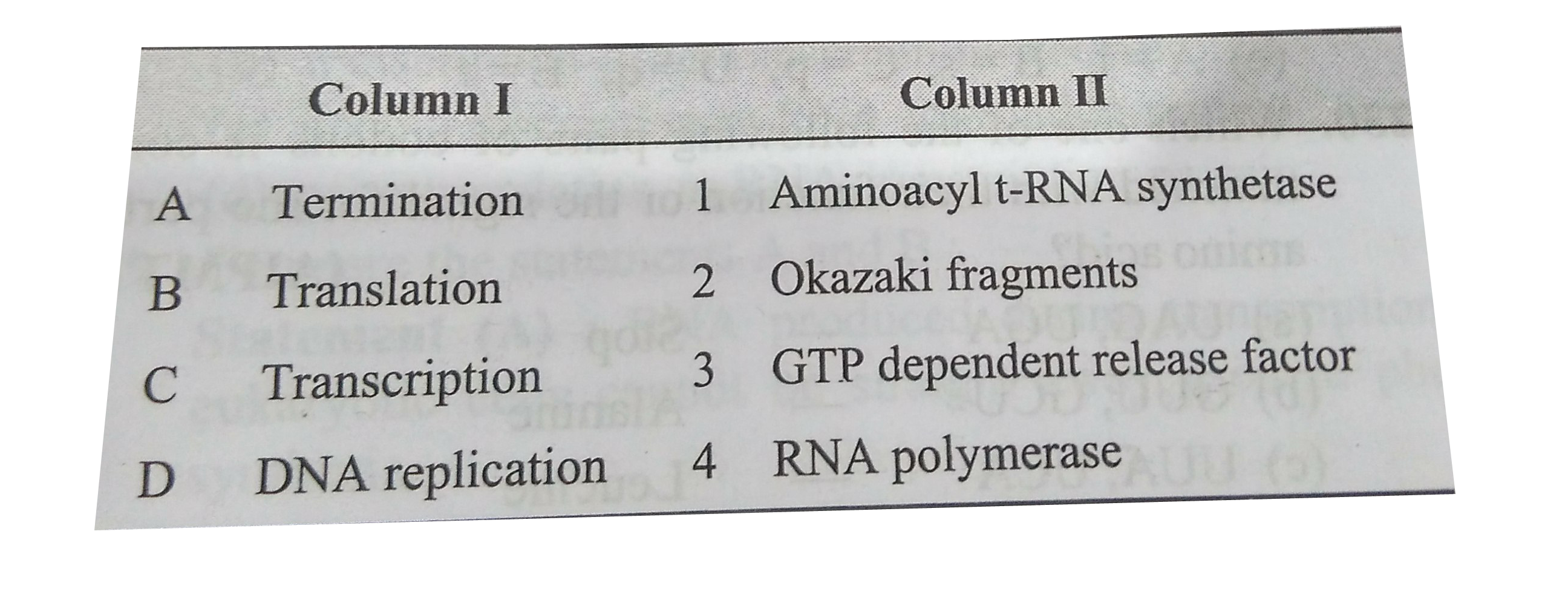Match the following with correct combination
A – 1, B – 2, C – 3, D – 4
A – 4, B – 3,C – 2,D – 1
A – 1, B – 3, C – 2, D – 4
A – 2, B –3, C – 1, D –4
The correct Answer is:B
To solve the matching question, we need to understand the definitions of the ecological relationships in Column-I and find the appropriate examples in Column-II. Let's break it down step by step:
Step 1: Understand Mutualism
- Definition: Mutualism is a symbiotic relationship where both species benefit from the interaction.
- Example from Column-II: The correct example for mutualism is "Crab and sea anemone". In this relationship, the crab gets protection from predators while the sea anemone gets food scraps from the crab.
Step 2: Understand Commensalism
- Definition: Commensalism is a relationship where one species benefits while the other is neither helped nor harmed.
- Example from Column-II: The correct example for commensalism is "Suckerfish and shark". The suckerfish attaches to the shark for transportation and feeding, while the shark remains unaffected.
Step 3: Understand Parasitism
- Definition: Parasitism is a relationship where one organism (the parasite) benefits at the expense of the other (the host), often harming it in the process.
- Example from Column-II: The correct example for parasitism is "Cuscuta on Cissus". Cuscuta is a parasitic plant that derives nutrients from the host plant Cissus.
Step 4: Understand Predation
- Definition: Predation is a relationship where one organism (the predator) kills and eats another organism (the prey).
- Example from Column-II: The correct example for predation is "Tiger and deer". The tiger hunts and eats the deer.
Final Matching
Now, we can summarize the correct matches:
- A (Mutualism) → 4 (Crab and sea anemone)
- B (Commensalism) → 3 (Suckerfish and shark)
- C (Parasitism) → 2 (Cuscuta on Cissus)
- D (Predation) → 1 (Tiger and deer)
Conclusion
The correct combinations are:
- A - 4
- B - 3
- C - 2
- D - 1
- Definition: Mutualism is a symbiotic relationship where both species benefit from the interaction.
- Example from Column-II: The correct example for mutualism is "Crab and sea anemone". In this relationship, the crab gets protection from predators while the sea anemone gets food scraps from the crab.
- Definition: Commensalism is a relationship where one species benefits while the other is neither helped nor harmed.
- Example from Column-II: The correct example for commensalism is "Suckerfish and shark". The suckerfish attaches to the shark for transportation and feeding, while the shark remains unaffected.
- Definition: Parasitism is a relationship where one organism (the parasite) benefits at the expense of the other (the host), often harming it in the process.
- Example from Column-II: The correct example for parasitism is "Cuscuta on Cissus". Cuscuta is a parasitic plant that derives nutrients from the host plant Cissus.
- Definition: Predation is a relationship where one organism (the predator) kills and eats another organism (the prey).
- Example from Column-II: The correct example for predation is "Tiger and deer". The tiger hunts and eats the deer.
Now, we can summarize the correct matches:
- A (Mutualism) → 4 (Crab and sea anemone)
- B (Commensalism) → 3 (Suckerfish and shark)
- C (Parasitism) → 2 (Cuscuta on Cissus)
- D (Predation) → 1 (Tiger and deer)
The correct combinations are:
- A - 4
- B - 3
- C - 2
- D - 1
Similar Questions
Match the following with correct combination
Column IColumn IIACuscuta1 SaprophyteBEichornia2PneumatophoreCMonotropa3 Insevtivourous plantDRhizophora4 ParasiteEUtricularia5 Root pocketView SolutionMatch the following column I with column II .
Column - IColumn - IIA - Metaphase - II1. Centromere with 2 kinetochoresB. Anaphase -I2. DisjunctionC. Mitosis3. SynapseD. Zygotene4. Plectonemic coilingView Solution
Knowledge Check
- Question 1 - Select One
Match the following with correct combination
ColumnIColumnIIA.Mutualism1.Tiger and DeerB.Commensation 2.Cuscuta and CissusC.Parasitism3.Sucker fish and shark D.Predation4.Crab and sea anemoneAA-1 , B-2 , C-3 , D-4BA-4 , B-3 , C-2 , D-1CA-1 , B-3 , C-2 , D-4DA-2 , B-3 , C-1 , D-4 - Question 2 - Select One
Match the following column with correct combination.
Column IColumn IIA Anthoceros1. AlgaB Adiantum2.HornwortC Sargassum3. GametophyteD Prothallus4. InferaeE Asterales5. Walking fernAABCDE25134BABCDE54321CABCDE51243DABCDE32154 - Question 3 - Select One
Match the following columns and Choose the correct combination from the given option :
Column - IColumn - II(A) Plantae(1) Bacteria(B) Fungi(2) Euglenoids(C) Protista(3) Phycomycetes(D) Monera(4) AlgaeAABCD4321BABCD1234CABCD3421DABCD4231
Match the columns I and II, and choose the correct combination from the options given.
Column IColumn IIa. Brassica1. Pusa Sawanib.Cauliflower2.Pusa Sadabaharc.Chilli3. Pusa Shubhrad. Okra4. Pusa SwarnimView SolutionMatch the following
(,Population interaction,Example),<br>(,1,Predation,A. Cuscuta & hedge plants),<br>(,2,Commensalism,B. Balanus & Chathamelus),<br>(,3,Parasitism,C. Cactus and moth),<br>(,4,Competition,D. Orchid and mango)View SolutionMatch the following columns
Column-IColumn-II(Population interaction)(examples)Amutualism1ticks on dogsBcommensalism2Balanus and chathamalusCparasitism3sparrow and any seedDcompetition4epiphyte on a mango branchEpredation5Ophrys and beeView SolutionMatch the following Columns.
Column IColumn IIA. Largest ovules1. Cannabis sativaB. Cuscuta3. Papaver sominiferumC. Drosera3. CycasD. Morphine4 Carnivorous plantE. Opium5. Parasitic plantView SolutionMatch the following in column I with column II and choose the correct combination :
 View Solution
View Solution
